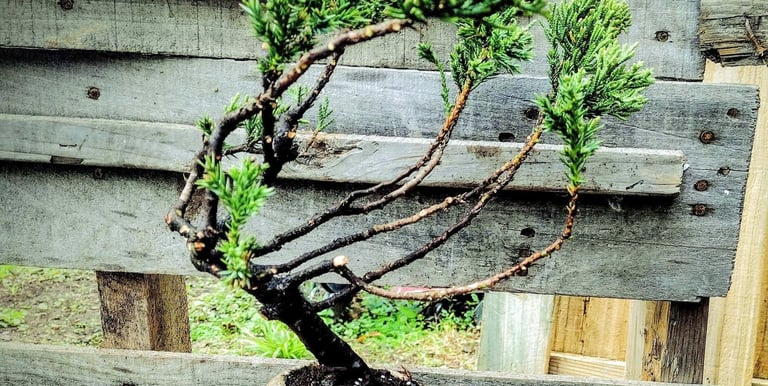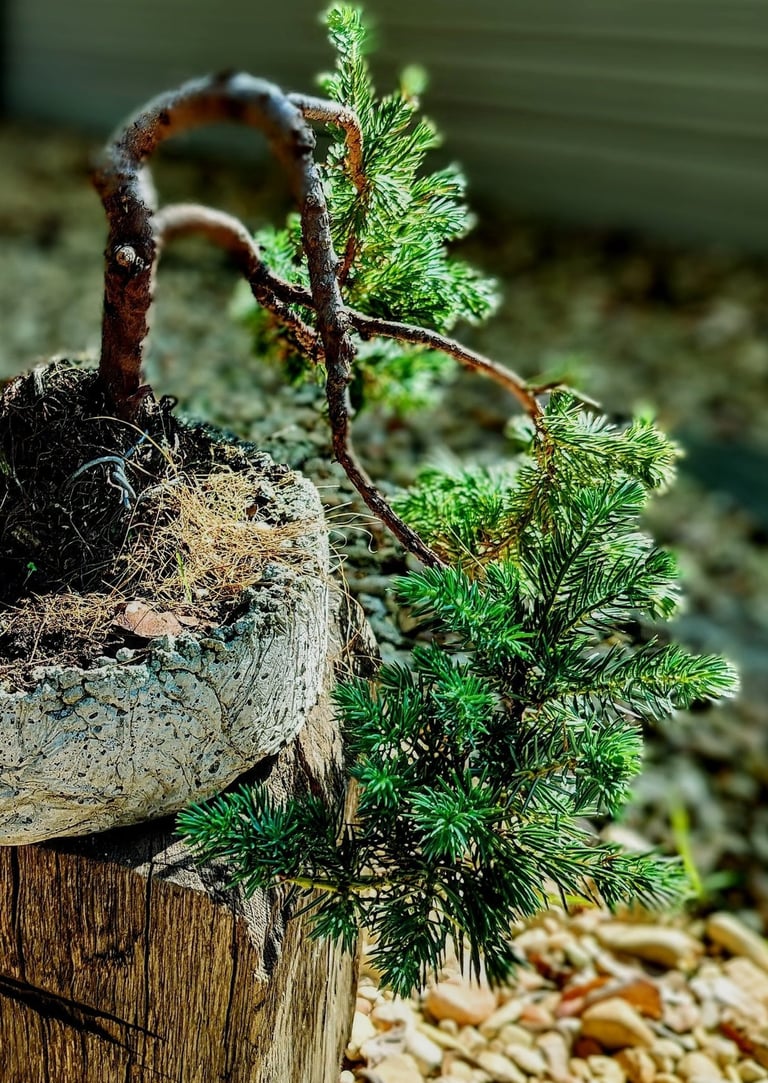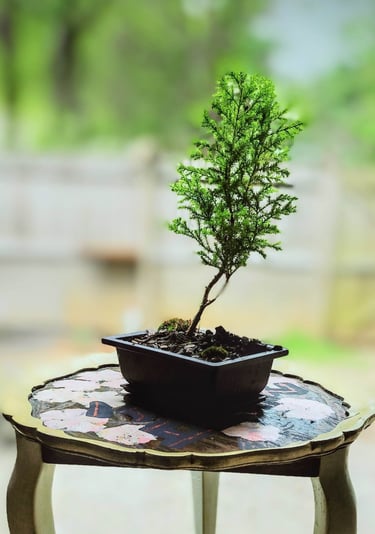Juniper Bonsai Care Guide
Explore essential indoor & outdoor care tips that ensure thriving juniper bonsai.




All About Juniper
Juniper (Juniperus) is a genus of evergreen coniferous trees and shrubs that belongs to the cypress family (Cupressaceae). The genus is widely distributed across the Northern Hemisphere, including North America, Europe, Asia, and North Africa. Here are some key details:
Origin and Distribution
Native to cold and temperate regions of the Northern Hemisphere
Found in diverse habitats ranging from arctic and alpine regions to subtropical areas
Grows naturally across North America (particularly the western United States), Europe, Asia, and parts of North Africa
Some species are adapted to mountainous regions, while others thrive in arid landscapes
Botanical Characteristics
Typically evergreen with needle-like or scale-like leaves
Produce small, berry-like cones that are actually modified seed-bearing structures
Can range in size from low-growing ground covers to trees up to 40 meters tall
Some species are very long-lived, with some individuals estimated to be over 1,000 years old
Ecological and Cultural Significance
Important for wildlife, providing food and habitat for numerous bird and animal species
Some species are used in traditional medicine
Juniper berries are famously used to flavor gin
Several species are valuable in landscaping and erosion control
Some varieties are drought-resistant and can survive in challenging environmental conditions
Interesting species include
Juniperus communis (Common Juniper): Widespread across the Northern Hemisphere
Juniperus virginiana (Eastern Red Cedar): Native to eastern North America
Juniperus scopulorum (Rocky Mountain Juniper): Found in western North American mountain regions.
The genus is quite diverse, with approximately 50-67 recognized species, showcasing remarkable adaptability across different ecosystems.
Caring for a Juniper Bonsai Indoors:
Tips and Instructions
Juniper, with its petite foliage and miniature, contorted form, is a popular choice for bonsai enthusiasts. However, keeping these miniature evergreens thriving indoors requires specific care and attention. Here are some tips and instructions to help your Juniper bonsai flourish:
Light
Sun-kissed: Junipers crave at least 4-6 hours of direct sunlight daily. Place your bonsai near a south-facing window or invest in a grow light. Insufficient light leads to leggy growth and weakened foliage.
Watering
Moist, not soggy: Water your bonsai when the top inch of soil feels dry to the touch. Deeply water until excess drains from the pot's bottom, but avoid waterlogging. Overwatering can cause root rot, a fatal condition.
Humidity boost: Junipers appreciate higher humidity than typical indoor environments. Mist the foliage regularly, place the pot on a pebble tray filled with water, or group your bonsai with other humidity-loving plants.
Soil and Potting
Well-draining mix: Use a well-draining bonsai soil mix (Superior Bonsai exclusively uses The Bonsai Boi's Bonsai Substrate and Blended Soil Organic Growing Medium from the very beginning with each tree) specifically formulated for bonsai and life in a small planter with limited resources. Please make certain to read https://reallivebonsai.us/bonsai-watering-about-bonsai-care. This typically includes akadama, pumice, and lava rock to ensure proper aeration and prevent waterlogging.
Potting needs
Choose a pot with drainage holes that's slightly larger than the root ball. Repot every 2-3 years to refresh the soil and accommodate root growth. Temperature:
Cool and breezy: Junipers prefer cooler temperatures between 50-70°F (10-21°C). Avoid placing them near heat sources or drafts. During cold winters, provide them with a period of dormancy in a cool, sheltered location.
Feeding
Moderate fertilization: Feed your bonsai with a diluted bonsai fertilizer during the growing season (spring and summer). Avoid over-fertilizing, which can lead to foliage burn.
Pruning and Styling
Maintaining shape: Regularly prune your juniper to maintain its desired shape and encourage bushier growth. Use sharp bonsai shears to pinch back new shoots and remove unwanted branches.
Wiring artistry
You can use thin wires to gently bend and shape branches over time, creating unique postures and enhancing the miniature tree's character.
Additional Tips
Rotate your bonsai regularly to ensure even sunlight exposure and prevent lopsided growth. Monitor for pests and diseases, and treat them promptly with natural or organic methods whenever necessary.
Enjoy the journey! Caring for a bonsai is an ongoing process, so be patient, observe your tree closely, and adjust your care practices as needed.
Remember, with proper care and attention, your Blue Star Juniper bonsai can thrive and bring a touch of nature's beauty into your home for years to come.
Blue Star Juniper
Care & Instructions
Procumbens nana Juniper
Care & Instructions
Indoor Care for Blue Star Juniper Bonsai Indoors
The Blue Star Juniper, with its steel-blue foliage and miniature, contorted form, is a popular choice for bonsai enthusiasts. However, keeping these miniature evergreens thriving indoors requires specific care and attention. Here are some tips and instructions to help your Blue Star Juniper bonsai flourish:
Light
Sun-kissed: Blue Star Junipers crave at least 4-6 hours of direct sunlight daily. Place your bonsai near a south-facing window or invest in a grow light. Insufficient light leads to leggy growth and weakened foliage.
Watering
Moist, not soggy: Water your bonsai when the top inch of soil feels dry to the touch. Deeply water until excess drains from the pot's bottom, but avoid waterlogging. Overwatering can cause root rot, a fatal condition.
Humidity boost: Junipers appreciate higher humidity than typical indoor environments. Mist the foliage regularly, place the pot on a pebble tray filled with water, or group your bonsai with other humidity-loving plants.
Soil and Potting
Well-draining mix: Use a well-draining bonsai soil mix specifically formulated for junipers. This typically includes akadama, pumice, and lava rock to ensure proper aeration and prevent waterlogging.
Potting needs: Choose a pot with drainage holes that's slightly larger than the root ball. Repot every 2-3 years to refresh the soil and accommodate root growth. Temperature:
Cool and breezy: Junipers prefer cooler temperatures between 50-70°F (10-21°C). Avoid placing them near heat sources or drafts. During cold winters, provide them with a period of dormancy in a cool, sheltered location.
Feeding
Moderate fertilization: Feed your bonsai with a diluted bonsai fertilizer during the growing season (spring and summer). Avoid over-fertilizing, which can lead to foliage burn.
Pruning and Styling
Maintaining shape: Regularly prune your juniper to maintain its desired shape and encourage bushier growth. Use sharp bonsai shears to pinch back new shoots and remove unwanted branches.
Wiring artistry: You can use thin wires to gently bend and shape branches over time, creating unique postures and enhancing the miniature tree's character.
Additional Tips
Rotate your bonsai regularly to ensure even sunlight exposure and prevent lopsided growth.
Monitor for pests and diseases, and treat them promptly with natural or organic methods whenever necessary.
Enjoy the journey! Caring for a bonsai is an ongoing process, so be patient, observe your tree closely, and adjust your care practices as needed.
Remember, with proper care and attention, your Blue Star Juniper bonsai can thrive and bring a touch of nature's beauty into your home for years to come.
Here are some additional resources you may find helpful
Juniper Bonsai Care Guide: https://www.bonsaiempire.com/tree-species/juniper
Blue Star Juniper Plant Care Guide: https://greg.app/FitPickleplant/plants/4bdbc6bb/
Bonsai Empire - Juniper Care: https://www.bonsaiempire.com/ebooks/juniper-guide
I hope this information helps you keep your Blue Star Juniper bonsai healthy and happy.
Indoor Care for Juniper Procumbens Nana Bonsai
Juniper Procumbens Nana is a popular bonsai choice due to its hardy nature and ability to adapt to indoor environments. Here are some key care tips to keep your tree healthy and thriving
Light
Bright, indirect light: This tree prefers plenty of light. A south-facing window is ideal.
Avoid direct sunlight: While it can tolerate some direct sunlight, prolonged exposure can cause leaf burn.
Watering
Keep soil watered regularly. Make sure humidity tray always has some water in it. When watering water thoroughly allowing water to drain through the bottom of planter. This will mean the soil has retained as much moisture as it can hold.
Never allow the planter or container sit in standing water other than when watering. The included humidity tray you will notice does not let water touch the bottom of the planter and is not in contact with the soil.
Water thoroughly. When you water, ensure the water drains freely from the pot.
Use room temperature water: Cold water can shock the roots.
Juniper is rare in that it can acquire up to 30% of its water needs through its leaves. Most plants and trees do not have any ability to acquire water in any way other than their roots. Juniper loves and benefits greatly from daily misting with a fine most water sprayer. Even twice a day a nice misting promotes foliage growth also which is exactly what we want for our bonsai. Mist away!
Temperature
Cool temperatures: These trees prefer cooler temperatures, ideally between 50-70°F (10-21°C).
Avoid heat sources: Keep your bonsai away from radiators or heat vents.
Humidity
Moderate humidity: Junipers prefer moderate humidity. Misting the foliage occasionally can help, especially during dry seasons.
Fertilizing
Always use ½ the amount of miracle grow called for indoor plants regardless of where you are growing yours indoor or out. Using ½ the indoor recipe you never “burn” or over fertilize your bonsai yet give them essential nutrients they benefit from. Once a month fertilization is recommended but skip November thru the end of January all together. Indoors or out the trees go dormant for the winter.
Repotting
Every 2-3 years: Repot your bonsai every 2-3 years to refresh the soil and prune the roots.
When you get ready to do so let me know and can provide my special bonsai Growing medium soil blend I make personally and sell by the pound.
Pruning
Any time Spring thru fall. Avoid pruning in winter months.
Use sharp, clean shears: Avoid damaging the branches. I often use a razor knife. In general I remove any growth that is aimed down and encourage any growth that is pointed up. That's the basic rule of thumb for promoting the desired “bonsai” look…
Pests and Diseases
Spider mites: Keep an eye out for spider mites, especially in dry conditions. Increase humidity or use a natural insecticide.
Root rot: Avoid overwatering to prevent root rot. Ensure proper drainage.
By following these guidelines, you can ensure your Juniper Procumbens Nana bonsai remains healthy and beautiful for years to come. The growing medium should feel moist to the touch but never soggy or wet.
Juniper care Instructions
by Variety

Contact Us
Reach out for bonsai care tips and guidance on junipers.
Customer Reviews
Read what our customers say about juniper bonsai care.
The care tips for juniper bonsai have transformed my indoor gardening experience.
Emily Johnson
San Diego
I found the bonsai care instructions incredibly helpful for my juniper trees. They thrive now, both indoors and outdoors, thanks to the detailed guidance provided.
Michael Lee
New York







